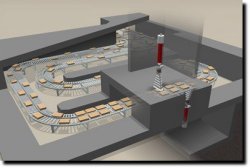
| Home | News | Articles | News Releases | Classified Ads | Techpapers | Links | Contact US | Media Kit |
 |
|||||||||
|
 Irradiating the Mail
Irradiating the Mail Is It Safe? Not for electronics or seeds By: Steve Fowler
Is irradiation of the mail safe? That depends on what is meant by safe. It is like any other industrial process dealing with energy. After all, radiation is just energy. It has the same inherent dangers as any process- no more - no less. From the human standpoint, it is very safe. However, from the packaged product standpoint, there are some drawbacks with which we will have to live.
In other words the use of radiation to sanitize the mail is justified from a safety standpoint but does come with some adjustments to our concepts of the postal system. If the total mail volume is irradiated or if the mail is randomly irradiated, the products which may be damaged will no longer be able to be shipped by standard mail. It is our opinion that the sanitizing of the mail needs to be from a systems approach using many methods of pathogen elimination. Some suggestions have been ETO gas such as now used in medical sterilization. Also Chlorine dioxide may be used. Some have suggested Ozone. The problem is that we do not have a good understanding of the lethal dose for Anthrax spores for these gases. More work needs to be done in this area. Our attempts to get such information was unsuccessful. We were told by the Center for Disease Control in Atlanta that this was the responsibility of the EPA. Calls to the EPA have not yielded any useful information as of this time. We are sure that radiation doses of 15 to 25 kiloGrays (1.5 - 2.5 MegaRads) will kill most of the spores. A study by the Centre for Applied Microbiology and Research in Salisbury, Wilkshire, UK suggests doses as high as 41 kGy may be required for sterilization. The good news about this is that almost any well designed system will eliminate the threat to a very workable level. It will make the effort by terrorists not justified and therefore be very successful. The
mail should be collected differently, sorted differently and have sanitizing
methods applied for the level of distribution. There were no deaths from
Anthrax in the offices of the News personnel or Senators who received
the letters. The only deaths outside of the 1st death at AMI in Florida
(Bob Stevens) were among postal workers and possibly associates. This
means if we now know of the threat and handle the mail with some caution,
the receiving party of a letter containing a pathogen may be able to be
contained and treated. However, those who handle the letter are at risk
due to the volume of mail and the lack of knowledge about each piece.
What this should mean is that the mail must be sanitized and contained
as early in the collection process as possible. While we need massive
radiation facilities for the accumulated volume of mail in central areas,
we must not neglect the need for sanitizing The
use of plastic bags would help contain and segregate the mail. Electron Beam Radiation Systems Electron
beams use the same electrons which we use everyday for electricity. The
main difference
X-ray Radiation Systems X-rays
are produced when high energy electrons are stopped abruptly in a dense
material such as Gamma-ray Radiation Systems Gamma rays are very simiar to X-rays in their penetrating ability. They are both electromagnetic energy as opposed to the electron which is an energetic partical. Gamma rays come from radioactive isotopes such as Cobalt-60 and Cesium-137. Cobalt-60 produces gamma rays which have an energy of about 1.25 MeV where Cesium-137 has rays with about 660 keV energy. The Titan and IBA systems can produce X-rays much more energetic than these two isotopes. Cobalt-60 and Cesium-137 are radioactive and can not be turned off. They must always be shielded. X-ray machines as well as electron accelerators are not a radiation source when their power is off. Cobalt-60 has a half-life of about 5 years. Cesium has a half-life of about 30 years. this means that after every half-life period the original activity of the source has been reduced by one half. This is a drawback for the economics of isotopes as sanitizing units. Some large gamma radiation systems have as many as 3.5 Mega Curies of Cobalt-60. In order to keep the source at strength the facility must replace about 1/3rd of the material each year at a cost of well over $1Million. Also, the Postal Service must consider that the large proliferation of gamma sources might make attactive targets for terriorists to spread a "dirty" bomb. The calculation of the dose need for sanitizing the mail may be made from the following relationships: 1 Gray
(1 Gy) = 1 Joule/kg ----------- 25 kGy = 25E3 J/kg a 1
kW system would present 3.6E6 J/hr. Of course these are maximums. There are many entrepreneurs who have begun to advertise solutions to the mail issue. These range from desk top irradiators to herbal potions. We recommend that if it sounds too good to be true, it probably is. Beware.
Radiation Safety is an important issue for the installation of these proposed systems. Most states require that a Radiation Safety Officer be on staff for each facility. These persons must have knowledge and experience with radiation safety. They typically must attend radiation safety training courses which are specific to the use of electron beams and X-rays for industrial uses. These systems are capable of being operated with little or no safety issues. In fact some users of electron beam systems have now operated almost 50 years with no safety problems.
|
||||||||||||||||||||